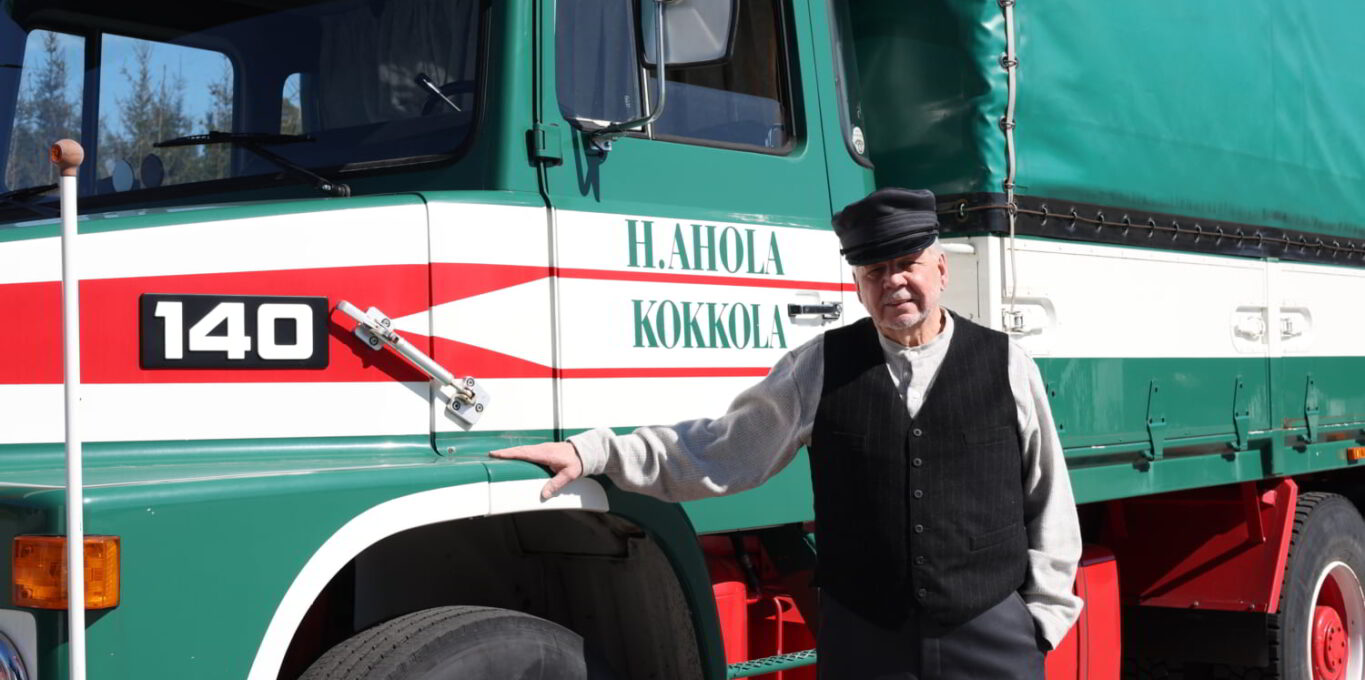22.05.2025
A Glance in the Rear-View Mirror – The Ahola Story and My Personal Journey from 1955 to Today
I turned 70 last year, and this year the Ahola Group marks its 70th anniversary. Although I do not feel old, I must admit that I have had the privilege of witnessing and experiencing many developments in the logistics industry first-hand.
Through this series of articles, I will do my best to describe what it has been like to be part of the tremendous development in the transport and logistics sector since 1955, when our parents, Helge and Gunn-Britt Ahola, founded the company.
I will divide my reflections on the industry’s evolution into observations from the 1950s, 60s, 70s, 80s, 90s, 2000s and 2010s, right up to the present day.
One observation is that these decades have encompassed quite a number of different crises.
Though not an obvious thought at first, but I was born just ten years after peace was declared in Finland. A major event during that era was the payment of war reparations, which Finland managed to complete in record time. The year was 1952 when Finland became the only country to fully repay its war debt – a total that ultimately reached nearly 600 million US dollars.
In today’s money, that sum would exceed 6.5 billion dollars.
Ships, locomotives, machinery and even houses were transported across the border as part of the reparations. If all the freight wagons had been placed end-to-end, they would have formed a train 36,000 kilometers long.
Although the war reparations were a heavy burden on our nation, they also had a positive effect. The Finnish export industry received a considerable boost in its trade with other countries. The paper, timber and engineering industries experienced strong growth as a result.
The Road Act Reform, which abolished municipal and village roads and reclassified them as local roads managed by the Finnish Road Administration, was introduced in 1954. The Act came into force in 1958. As soon as state funds began to be released from the reparations program, they were allocated to road renovation and construction. This also created employment opportunities for tens of thousands of people who had been left jobless during the unemployment crisis of the 1950s. With the support of World Bank loans, road construction in Finland was brought up to modern standards.
We also experienced other post-war effects during the 1950s, such as a rationing-based economy, which also impacted the ability to buy quality Western cars.
The Company’s First Year and Its Vehicles
The 1950s in Finland were marked by relative poverty, and food rationing ended in 1954 – the same year I was born.
My father, Helge, began with a truck he bought from his employer at the time. It was a 1949 Ford, but it was replaced later that same year with a Dodge. Both vehicles ran on petrol, which was typical at the time.
In 1957, Helge purchased his first diesel truck – a so-called “Cologne-Ford,” equipped with a two-stroke diesel engine. The only impressive feature of this vehicle was its powerful roar, which resembled that of an airplane. In all other respects, the truck was extremely unreliable. In the first year alone, the engine had to be repaired twice.
My parents have told me about the significant fluctuations in earning potential during the 1950s. If there were transport jobs available all year round, it would be possible to pay off the truck within twelve months.
However, cold winters made things particularly difficult when there was no road construction. Times were hard, and my mother had to help make ends meet by sewing leather jackets during the more challenging periods. One particularly difficult period came in 1956, when Finland was paralyzed by a general strike that lasted throughout March.
A Driver’s Work in the 1950s
What was it like to be a driver back then? Vehicles in those days were not designed with the driver’s comfort in mind – everything was focused on getting them to work mechanically.
Even then, I used to accompany my father on his deliveries. For example, when transporting sand, the loading was done manually with shovels. The shovels were large, and you had a helper with you, so it did not take too long to load 3.5 cubic meters of sand. After reversing right up to the sandpit, the load could usually be shoveled and loaded up quite quickly.
In the early 1950s, trucks were not yet equipped with hydraulic tipping. To unload a gravel load, the bed had to be cranked up by hand. The bed held about 3.5 cubic meters, so with a good gear ratio, the task was manageable. The cab had no heating system, which made for bitterly cold conditions in winter. Another common issue was that exhaust fumes could seep into the cab.
During the 1950s, drivers generally enjoyed a high standing in society. They wore uniforms, which varied slightly depending on whether they worked with trucks, buses or taxis.
Despite the many challenges, there was a broadly optimistic outlook on the future. The economy was growing steadily, at an annual rate of 4–5%. Most roads were gravel and in poor condition, which created a clear need for new road construction. The war and rationing were behind us, and confidence in the future was strong.
One thing that has always struck me about truck manufacturing is how long it took for the driver’s comfort to be taken into account.
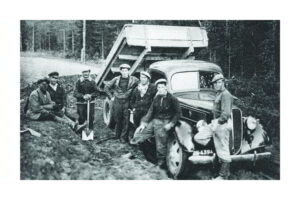
Roadworks in progress – my father, Helge, standing on the far right. Roadworks employed many people, in part as a form of emergency relief work.

Versatility and flexibility were already essential even back in the 1950s. Petrol was delivered in barrels for distribution across rural areas.
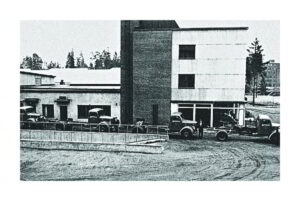
Helge picks up his first Scania-Vabis LS 51 from Helsinki. Our first proper truck, a remarkably durable and dependable workhorse. As I recall, I had a say in the decision to go with Scania-Vabis.
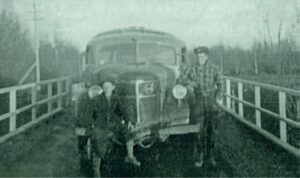
My father, Helge, on the left, working as a driver for Fride Nyberg.
This is probably the same truck he bought from Fride in 1955.
The Prerequisites for a New Hauler in the 1950s
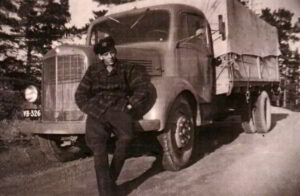
To conclude, I would like to summarize a few observations that I believe capture the essence of the 1950s – and of the conditions that shaped the launch of the transport business founded by my father, Helge, and my mother, Gunn-Britt.
The General Situation in Finnish Society
– Rationing ended in 1954
– Transition from a regulated economy to a consumer economy
– Shift from an agrarian society to industrialization
– Strong belief in the future
– Major focus on infrastructure development, also carried out as a form of emergency relief work
– The export industry gained solid momentum after the war reparations were paid
The General Situation in the Transport Sector
– Vehicles were of poor quality and typically petrol-powered
– Road conditions were poor, paved roads were rare
– The work involved a great deal of physical labor for drivers
– A high degree of flexibility was required to handle all types of transport assignments
– Diesel vehicles only became common in Finland in the latter half of the 1950s
The Early Years of Helge and Gunn-Britt’s Haulage Business
– Helge bought his first truck from his employer, Fride Nyberg. My mother cycled to Fride once a month to make the instalment payment. According to her, I rode along on the luggage rack.
– When there were enough jobs, the business was highly profitable. However, during cold winters, long gaps between transport assignments were not uncommon. To make ends meet, my mother took on work as a seamstress. Incidentally, my mother was a tremendous support to my father with her ever-positive outlook.
– In 1959, my father bought his first proper truck– a Scania-Vabis L-51 – a very good and durable vehicle. With the help of that truck, they managed to stabilize their finances after the catastrophic “Cologne Ford”, which was constantly breaking down.
I feel I had a role in the decision to go with Scania-Vabis. I was with my father on a job when we spotted a similar Scania-Vabis belonging to a colleague. I pointed it out and told him that we had to get one just like that.
Hans Ahola
Chairman of the Board
Ahola Group
